The 2015 MacBook Review
by Ryan Smith on April 14, 2015 10:15 AM ESTWindows Performance
Shifting gears from OS X, let’s take a look at performance under Windows. Though not every MacBook will be used with Windows, Windows gives us a wider selection of benchmarks to work with, and it gives us a chance to compare the MacBook to some contemporary PCs.
For our Windows comparison I’ve pulled in a number of results from our most recent Core M review, including other Core M laptops, the Haswell-U powered Surface Pro 3, and a couple of Broadwell-U powered laptops. Of particular interest is likely the Asus UX305, which is another Core M based laptop that uses a very similar build. At 13.3” it’s larger than the MacBook, but it is a similar aluminum fanless design.


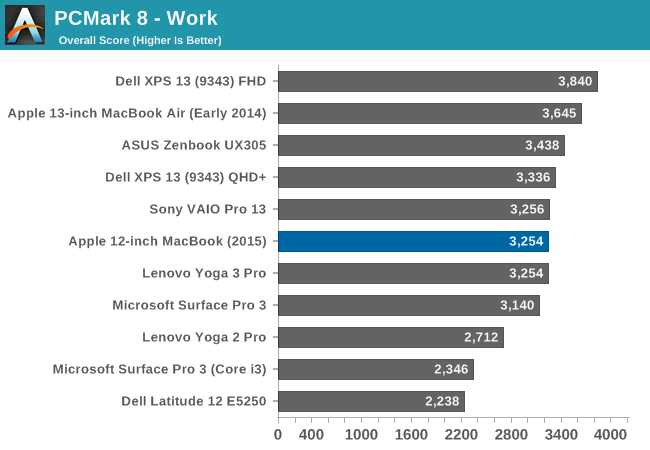
Depending on which sub-test we’re looking at, the PCMark workloads are a mix of bursty workloads, lightly threaded workloads, and heavily threaded workloads. As a result the MacBook and its Core M processor are given some opportunity to show off, and at other times is pushed back due to its cap on sustained performance.
The Home workload is one such light test, which plays into the MacBook’s favor. Here it’s towards the top of the charts, surpassing everything other than the Core M based Asus UX305, and then the more powerful Broadwell-U based Dell XPS 13s. I keep rattling on about workload types and this is a good example of why it matters, because in a light workload the MacBook is among the fastest of the ultra-portables, beating out many other Core M devices and also some Haswell based Ultrabooks. Put another way, in a light workload Core M can already deliver (and at times exceed) one-generation old Haswell Ultrabooks.
As for the Creative and Work workloads, the MacBook still places relatively well. Doing this well on the Creative workload was a bit of a surprise, since it’s the most demanding benchmark of the 3. I suspect we may be seeing a mix of dividends from the SSD and Core M’s GPU, Otherwise the lighter Work test actually has the MacBook farther behind the pack, with performance in-line with other Core M laptops, though not as exciting compared to the Ultrabooks.
Overall, between our OS X and Windows CPU benchmarks, what we’re finding is that the performance of the MacBook generally mirrors our expectations given what we know about its design and component selection. Given a light workload that allows the Core M CPU inside of the MacBook to turbo to its fastest speeds, it’s a very potent competitor in a small package, able to give all but the most recent Ultrabooks a run for their money. However heavier, sustained workloads drive a wider gap in between the two classes of devices, and in those cases the MacBook offers performance closer to Ultrabooks a 3-4 years old.
Shifting gears one more time, let’s take a look at GPU performance. GPU workloads present an interesting scenario for Core M, and by extension the MacBook. The underlying Intel HD Graphics 5300 GPU is a GT2 configuration, making it moderately powerful for an iGPU, however the power and thermal constrains on the MacBook means that the laptop doesn’t have the power required to run a GT2 GPU at full speed.
With the Broadwell CPU cores alone able to chew up 4.5W and then-some, a combined GPU+CPU workload will generally put the MacBook in a pinch. Consequently I don’t see the MacBook being used as any kind of gaming machine – the MacBook Air is undoubtedly a much stronger contender – but it’s useful to put this performance in context.
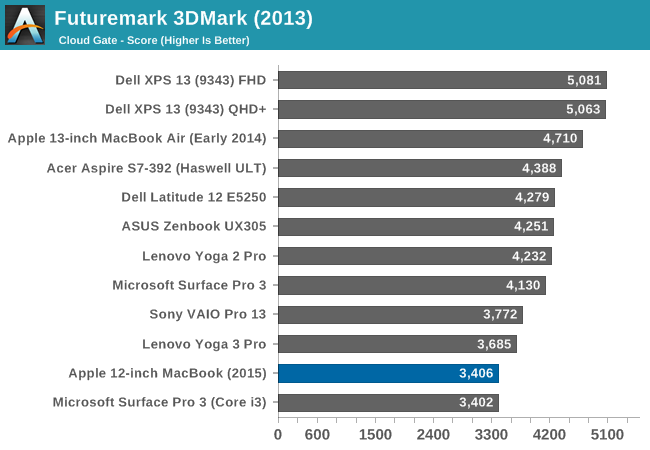
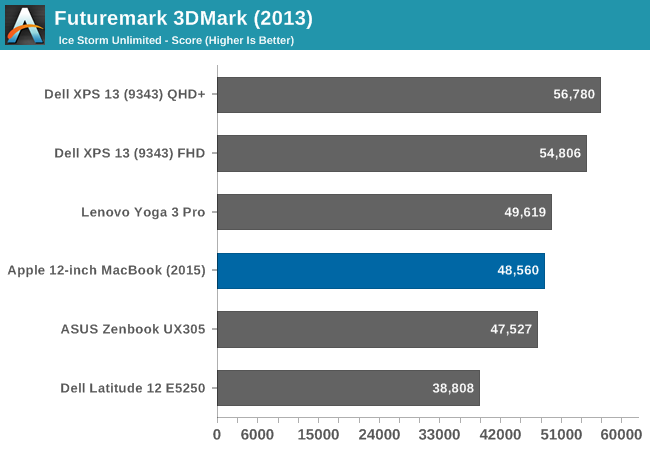
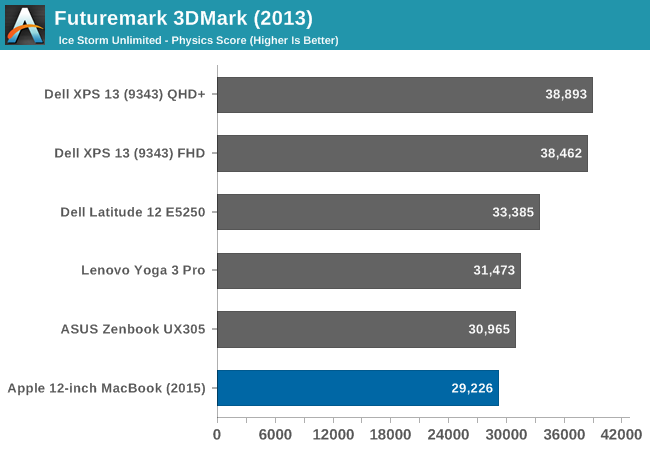
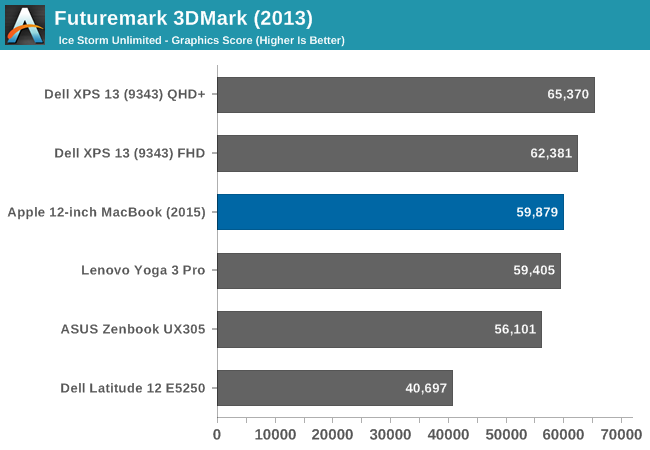
Our 3DMark scores handily illustrate this exact point. Facing significant power and thermal limits, the MacBook has to pull back in performance and consequently ends up near the bottom of our charts, versus its much better showing in PCMark. The 2014 MacBook Air 13” is some 38% faster at Cloud Gate, and on the newer Ice Storm benchmark the results aren’t much better. Of the two it’s worth noting that Cloud Gate is a much more complex and longer running benchmark, whereas Ice Storm is a quick running tablet-sized benchmark. Consequently Cloud Gate throttles harder and sooner, which is why the MacBook does relatively worse there. Overall the MacBook doesn’t even beat any of the other Core M laptops, which is a bit surprising. But nothing here is quite like the MacBook, so it’s somewhat different in its combination of small size and aluminum chassis.
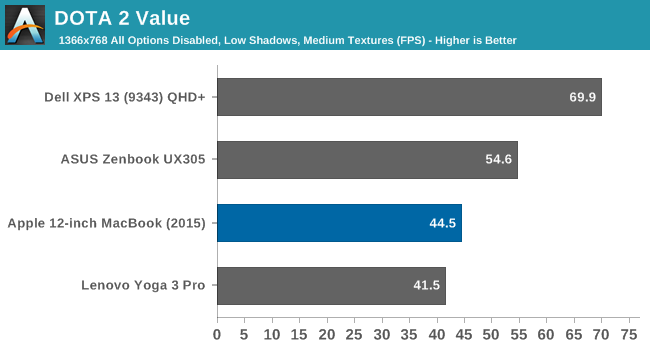
Meanwhile I have also run our DOTA 2 Value benchmark against our other Core M devices and the Broadwell-U based Dell XPS 13 for good measure. On an absolute basis 44.5fps is definitely playable for a game like DOTA, however on a relative basis this is a weaker showing than the UX305, not to mention the XPS 13. Compared to the UX305 the MacBook again appears to be throttling sooner and harder, whereas the Ultrabook-sized XPS takes full advantage of its higher power limits and better cooling.
Ultimately as we said when opening up our look at GPU performance, the MacBook’s GPU is potent on paper, but it simply doesn’t have the power and cooling capabilities needed to take full advantage of it. This means that while CPU performance isn’t too far removed from the Ultrabooks, GPU performance absolutely is.
Finally, I wanted to take one last look at performance relative to the tablets, this time from a GPU perspective.
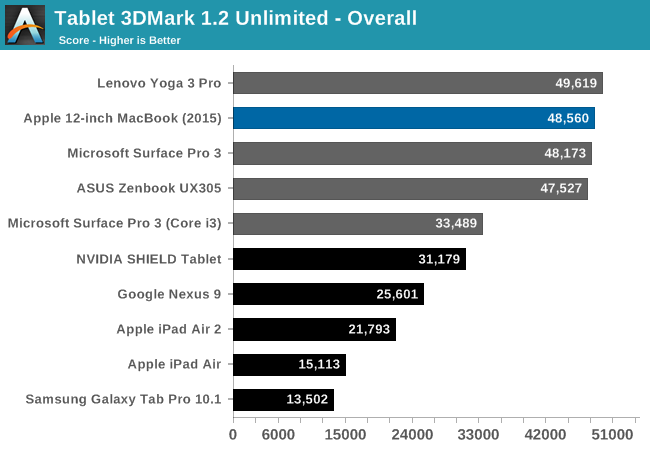
While the iPad Air 2 makes a good run on the MacBook in the web benchmarks, it and the other tablets are even more power limited than the MacBook, and as a result their GPU performance is even more constrained. The MacBook still has a better than 2x lead on the iPad Air 2 in this GPU benchmark, so judging from this it will be some time yet until an iPad's GPU performance catches up with this MacBook's.










354 Comments
View All Comments
RT81 - Wednesday, April 15, 2015 - link
The presence of "no touch screen" complaints, as few as they are, is interesting. There's a whole demographic of Mac users (creative professionals, mostly) that are sweating bullets about the possibility of iOS and OS X converging. A touch screen Mac would probably give them a heart attack.Apple has said they don't have any intention of doing that. It didn't go over so well for Microsoft, but who knows. It wouldn't be the first time Apple has said "we'll never do that" but what they really mean is "we'll never do that until we can do it at the standard of quality we want".
senzen - Wednesday, April 15, 2015 - link
Very good, thorough review. As soon as I sold my 2010 MBA 11 to get an MBPr Pro I missed the smaller size and weight, but I wanted a retina display for when I travel and take photos, so the new Macbook ticks all the boxes. My doubt was the performance, but seeing it apparently does at least as well as the first i5 MBAs is reassuring, I don't need more. I'm still tempted to wait for the second generation, which is reinforced by Apple's inability to actually show these in stores. I wonder if the upgrade to the faster (less slow) processor is worth it.Malac - Wednesday, April 15, 2015 - link
I think two tests that I feel would be very interesting are missing:- Remote Desktop streaming
- Virtual Machine Benchmark
I sometimes play PC games streamed from my powerful desktop to my MacBook Air using Microsoft Remote Desktop or Steam. While this works well, the air does get hot sometimes and I hear the fans. How would the MacBook handle such a load?
And how well does a VM work? Lets say VirtualBox + Linux with a graphical frontend?
Ryan Smith - Wednesday, April 15, 2015 - link
Steam in-home streaming uses H.264, so all the heavy lifting should be done by the video decode block, and the end result not much harder than decoding any other 1080p60 H.264 stream.jeffry - Wednesday, April 15, 2015 - link
Nice. Apples "new" butterfly mech. Thats a copy of how the japs have done it years ago in their Sony Vaio SZ Series notebooks...nerd1 - Wednesday, April 15, 2015 - link
Why mention tablet laptop crossover at all? This laptop is not convertible, not derachable, lacks touchscreen or pen. It is by all means just a thin, lightweight laptop (with LESS endurance and power)Ryan Smith - Wednesday, April 15, 2015 - link
The short answer is because internally it's built like a tablet, not a laptop, and that's the primary point I'm trying to make when discussing its construction.nerd1 - Thursday, April 16, 2015 - link
Built like a tablet? What does it mean at all? How does crippled laptop becomes a tablet?Some tablets are more powerful and expandable than MBA 11" (which is a LAPTOP).
nerd1 - Wednesday, April 15, 2015 - link
Oh and samsung released very similiar laptop (core m, 1600p display, 2lbs) with usb, sd slot and separate power jack months before.solipsism - Wednesday, April 15, 2015 - link
1) I think it's both odd and wrong that Ryan Smith would repeatedly try to state this is some sort of Mac-iPad hybrid. It doesn't run iOS, it has an attached keyboard and trackpad, it doesn't even have a touchscreen display (something increasingly more common on notebooks). This is a notebook computer designed to run a desktop-grade OS.2) This is not a netbook. Even if we ignore all the low-quality, budget-focused design constraints that that made the netbook really only good* for surfing the "net", this machine has a CPU that costs more than the average notebook and that is magnitudes more powerful with a similar power envelope. If it's to be classed at anything it is an Ultrabook, sans the official branding.
3) Apple's USB-C adapters aren't that pricey. If one wants, they can buy the adapters that Google sells for their new Chromebook Pixel or wait for other vendors (my favourite is Monoprice) to offer up their own solutions since this is, after all, USB. There will also likely be 3rd-party external displays from everyone(?) that will use a single USB-C port for both charging the device and pushing data, which will have their own variety of built-in hubs for those wanting an external display which makes the majority of these complaints for a nascent standard just coming to market moot.
4) People are lamenting the loss of MagSafe, but is that really feasible with how small the 3rd(?) MagSafe adapter would have gotten for this machine? Also, if it's designed to be used remotely and designed to be almost always used without cabled peripherals, is it really an issue for its intended market? Personally, I love how the Chromebook Pixel has USB-C on each side and how either can charge the device. I've moved an entire office around because of how the plug on the left-hand side was causing it to wear out after about 6 months due to being plugged into the wall at the right. This was never an issue when PVC was still included in cables (speculative cause and effect). Hopefully when the MBPs get this feature it will be on both sides.
5) So why bring back the MB and not simply call it the MBA (not unlike how they keep the non-Retina MBPs and came out with the new Retina MBPs with a new design)? Eventually I would like to see the MBA get the exact same external HW design and components (i.e.: Retina display with the same 12" design only) but running Mac OS X — or a Mac OS X-like OS — on Apple's A-series chip. This could allow Apple to move their "PC" sales to even lower end of the market by being able to drop the cost by a few hundred dollars whilst still being able to have a machine that performs well. I do think the A-series chip may need some additional revisions (but we really don't know what is possible with their bespoke design) and for Mac OS X to get another housecleaning, perhaps even rewritten in Swift.
* Calling a netbook good at anything is a stretch, especially when even Adobe Flash would stutter on even 480p video due to its inept HW.